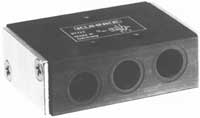What are Common Pneumatic Valve Types
There are many common uses of pneumatic valves, so they come in many different variations. The most common pneumatic valves include:
- Air-Piloted

- Manual
- Mechanical
- Solenoid-Piloted
- Vacuum-Piloted
Regardless of the valve type, a pneumatic valve is a crucial component of pneumatic control systems. When deciding on which valve best suits an application, the most important factor is the valve's design. Although specialty options exist, four standard valve designs include:
- Diaphragm
- Poppet
- Spoppet
- Spool
Of the four above types, poppets valves are the most commonly used. They utilize a rubber molded poppet that is wrapped around a stem. It moves along the valve's bore, which creates a strong seal when the poppet is fully in its seat. Unlike the other three above, poppet valves are compatible with a wide range of media (not just compressed air). A poppet also offers excellent exhaust capacity, which means that this design can have high flow rates.
Pneumatic Valves
A Spoppet valve combines the design of a poppet and a spool valve. The design blends the primary poppet sealing with a small number of sliding seals. This design results in reduced sensitivity to lubrication. The sliding seal is engaged in an operation to reduce drag within the valve body. These pneumatic valves are designed to bridge the limitations and gaps left when using popper or spool valves. It would help if you considered using these valves when you require cost-efficient 3 or 4-way valves to be used in different applications and environments.
Pneumatic Controls
- Why Should I Use Pneumatic Control Systems
There are many reasons why pneumatic controls and pneumatic valves are used.
- Increasing the Efficiency of Pneumatic Valve and Control Systems
- A Review of Pneumatic Control Systems


- Ellis/Kuhnke Controls
132 Lewis Street Unit A-2, Eatontown, N.J. 07724
Phone: 1-800-221-0714
Fax: 732-291-8154
Email: Info@ekci.com
- Home Pneumatic Controls Technical Info CAD Drawings Contact Us Pneumatic Timers Blog Site Map
